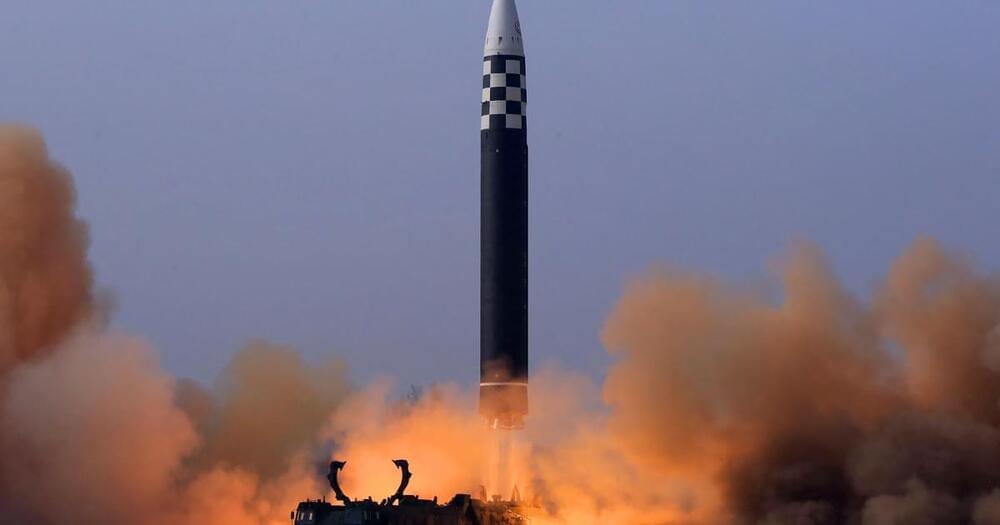If the trials go well, it could become a longevity treatment for civilians too.
The U.S. military is developing an anti-aging pill that is designed to inhibit performance reduction that comes with aging.


It claims the ICBM is the largest ever launched.
Reports are in that North Korea have just test-launched their new” Hwasong-17” intercontinental ballistic missile. The longest-range missile platform developed to date by the country, it has been developed, by all accounts, to help “contain” U.S. military threats.
The test launch was guided by North Korean leader Kim Jong Un on the 24th of March 2022.

Rodolfo Salas, chief of paleontology at Peru’s National University of San Marcos, said that the whale was a “sea monster.”
“The most incredible thing is that the skull is in a very good state of preservation, it has complete teeth; it was a first-order predator, at the top of that time that fed on fish penguins; a sea monster just as they imagine it and we think it is a new species,” Salas said.
The “Ocucaje Predator,” as the researchers dubbed it, was about 55 feet long and used its massive, powerful teeth to feed on tuna, sharks and schools of sardines.

Did they purposely set out to create inventions that will bring death and blood shed?🤔
Usually when drafting a Patent Claim for any invention, the Inventor states the benefits of the invention to the society.
Looking at the picture below i am tempted to ask, of what use are Nuclear bombs and other weapons of mass destruction of benefit to the society?
I know that Innovations and Inventions are necessary for a nation’s growth and development but it should not be at the expense of human life.
I pray and hope that peace will be restored soon for the sake of her Citizens.
#inventions.
#patents

Australia gets its own space force.
The Australian government yesterday launched the Space Command, a new defense agency with echoes of the US’ Space Force that has been tasked with securing the country’s place in an “already contested” cosmos.
Australian Minister for Defence Peter Dutton said the new defense arm would be modest to start with, although he gave no detailed staffing or budget figures.
In a speech to the Australian Air Force, he said that space “will undoubtedly become a domain that takes on greater military significance in this century.”
Space is becoming more congested and is already contested, particularly as the boundaries between competition and conflict become.
Putin’s war on Ukraine is entering week four. What is the Russian president’s thinking, and what is his endgame? If anyone would know, it would be Dmitry Peskov. He has served as Putin’s chief spokesperson for more than two decades. He was at the president’s side during his rise to power. As a close confidante of Putin’s, Peskov is also a high-profile target for Western sanctions. He joins the program from Moscow for an exclusive interview.
Originally aired on March 22, 2022
For more from Amanpour and Company, including full episodes, click here: https://to.pbs.org/2NBFpjf.
Like Amanpour and Company on Facebook: https://bit.ly/2HNx3EF

A.I. is only beginning to show what it can do for modern medicine.
In today’s society, artificial intelligence (A.I.) is mostly used for good. But what if it was not?
Naive thinking “The thought had never previously struck us. We were vaguely aware of security concerns around work with pathogens or toxic chemicals, but that did not relate to us; we primarily operate in a virtual setting. Our work is rooted in building machine learning models for therapeutic and toxic targets to better assist in the design of new molecules for drug discovery,” wrote the researchers in their paper. “We have spent decades using computers and A.I. to improve human health—not to degrade it. We were naive in thinking about the potential misuse of our trade, as our aim had always been to avoid molecular features that could interfere with the many different classes of proteins essential to human life.”
Full Story:
Researchers from Collaborations Pharmaceuticals tweaked artificial intelligence to look for chemical weapons, and impressively enough the machine learning algorithm found 40,000 options in just six hours.

The first Australian-produced military combat aircraft in over half a century.
Boeing’s Loyal Wingman is now officially the “MQ-28A Ghost Bat.” The new military designator and name that will be used by the Royal Australian Air Force (RAAF) for the autonomous combat drone was announced during a ceremony at the Amberley Royal Australian Air Force Base in Queensland today.
Giving the Loyal Wingman an official name may seem trivial, but it represents two major steps for the program. Being named after a native Australian bat, it acknowledges the first Australian-produced military combat aircraft in over half a century, and it also shows that the drone is moving out of the experimental phase and into a path for full deployment with the RAAF and sales to international customers.
Taking only three years from the first design to first flight, the Ghost Bat’s rapid development owes much to Boeing Australia’s use of digital engineering and advanced manufacturing techniques. When in service, the autonomous combat craft will have the performance and range comparable to that of a conventional fighter aircraft. This will allow it to carry out single missions and team with other crewed or uncrewed aircraft.

Is he planning to burn everything down if he can’t win?
Russian President Vladimir Putin has reportedly ordered a nuclear war evacuation drill amid the war in Ukraine. A nuclear war evacuation drill is the process in which people are taken to safe places to prepare for the eventuality of nuclear war. The purported directive comes amid fears of President Putin resorting to extreme measures to force a decisive victory in the Ukraine war.
#russia #russiaukrainewar #nuclearwar.
00:00 — Introduction.
00:28 — Putin Orders A Nuclear War Evacuation Drill.
01:06 — Kremlin Generals ‘Shocked’ By Order.
02:21 — Putin’s Nuclear Threats And Speculation About Family.
04:03 — Russia’s Hypersonic Missile Attacks In Ukraine.
Follow CRUX on Instagram (@crux.india): https://bit.ly/3qSFx1K
Follow CRUX on Facebook: https://bit.ly/2Lte7iF
#GetCloserToTheNews with latest headlines on politics, sports and entertainment on news18.com https://bit.ly/2Y4QccL
Also watch: